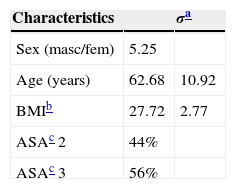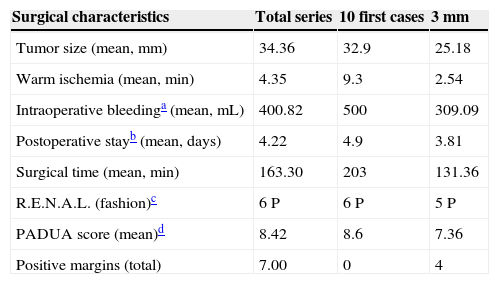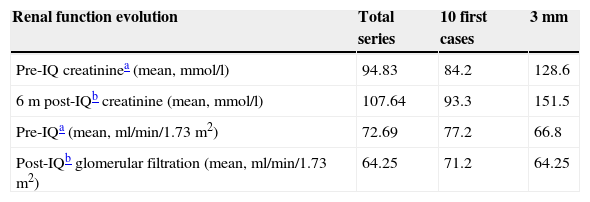The guidelines recommend partial surgery for T1 renal tumors. Various aspects of this surgery have evolved in recent years, including the clamping method and duration, enucleation, the retroperitoneoscopic approach and the use of 3mm ports. We present our initial series on laparoscopic renal tumourectomy by retroperitoneoscopy (LRTR) and analyse our learning curve and use of 3-mm instrumentation.
Material and methodsFrom January 2011 to January 2015, we performed LRTR on 50 patients with posterior or convex T1 renal tumors. After 10 cases, the technique changed to off-clamp, and 11 cases were subsequently performed with 3mm instrumentation.
ResultsThe mean tumor size was 34.36mm (14–62), with a mean PADUA score of 8.42 (5–12). The mean operative time was 163.1min (75–300), and the mean warm ischemia time was 4.21min (0–28). The main renal artery was not clamped in 41 (82%) patients, and no vessel (zero ischemia) was clamped in 39 (78%) patients. Seven cases had positive margins (6 focal). Eleven LRTRs were performed with 3mm instrumentation, with shorter surgical times, less intraoperative bleeding and shorter hospital stays.
ConclusionsRetroperitoneoscopy coupled with enucleation enables the extirpation without clamping of posterior renal tumors, with a relatively short learning curve. The 3-mm material enables the technique to be performed, although in our experience it has resulted in a higher rate of positive surgical margins.
Las guías recomiendan cirugía parcial en tumores renales T1. Diferentes aspectos han evolucionado en estos últimos años: forma y duración del clampaje, enucleación, abordaje por retroperitoneoscopia y la utilización de puertos de 3mm. Presentamos nuestra serie inicial de tumorectomía renal laparoscópica por retroperitoneoscopia (TRLR) analizando nuestra curva de aprendizaje y el uso de instrumental de 3mm.
Material y métodosDe enero 2011 a enero 2015, realizamos TRLR a 50 pacientes con tumores renales T1 de cara posterior o convexidad renal. Tras 10 casos, la técnica pasó a ser off-clamp y posteriormente en 11 casos se realizó con 3mm.
ResultadosEl tamaño tumoral fue de 34,36mm (14–62) con un PADUA de 8,42 (5–12), tiempo operatorio de 163,1 minutos (75–300) y tiempo de isquemia caliente de 4,21 minutos (0–28). No se clampó la arteria renal principal en 41 (82%) pacientes y ningún vaso (isquemia 0) en 39 (78%). Siete casos presentaron márgenes positivos (6 focales). Se realizaron 11 TRLR con material de 3mm con un tiempo quirúrgico, sangrado intraoperatorio y estancia hospitalaria menores.
ConclusionesLa retroperitoneoscopia sumada a enucleación permiten la extirpación sin clampaje de tumores posteriores del riñón con una curva de aprendizaje relativamente corta. El material de 3mm permite realizar la técnica aunque en nuestra experiencia ha resultado en una mayor tasa de márgenes quirúrgicos positivos.
Artículo
Comprando el artículo el PDF del mismo podrá ser descargado
Precio 19,34 €
Comprar ahora










